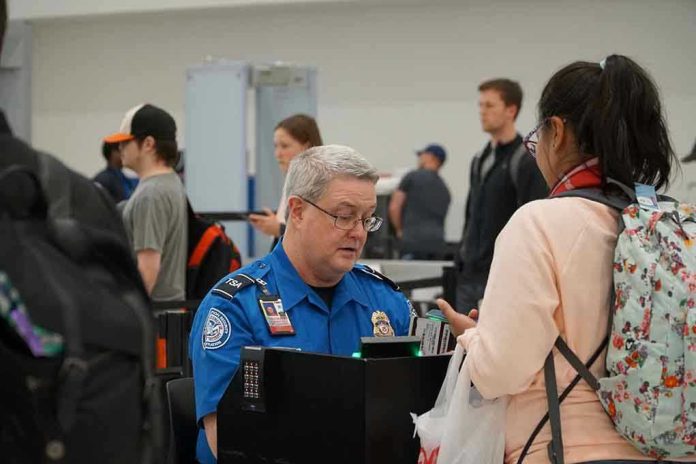
Imagine taking off your shoes, belt, and dignity at airport security—only to have a government scanner flag your groin not once, but twice, all because you had the audacity to sweat. Welcome to the state of American air travel, where the real threat to your privacy might just be your own perspiration.
At a Glance
- TSA full-body scanners routinely trigger false alarms in sensitive areas due to sweat and moisture, resulting in invasive pat-downs.
- TSA admits that perspiration can change the density of clothing, confusing their multi-million dollar scanners.
- Passengers face repeated embarrassment and delays, while the agency insists it’s all in the name of “public safety.”
- Recent policy tweaks aim to make security less painful, but the technology’s flaws remain—and so does the frustration.
Sweat, Scanners, and Security Theater
The TSA’s Advanced Imaging Technology scanners, installed to catch what metal detectors can’t, have become notorious for flagging passengers’ groin areas—sometimes over nothing more sinister than a little perspiration. That’s right: your summer vacation could get off to an awkward start not because you tried to sneak shampoo through security, but because you dared to sweat on a hot day. TSA officials themselves admit it. According to the agency, “Added moisture from a person’s body can alter the density of clothing, so it is possible perspiration may cause our Advanced Imaging Technology (AIT) machines to alarm.” That’s the kind of cutting-edge defense our tax dollars are buying—machines that can’t tell the difference between an explosive device and yesterday’s gym shorts.
These scanners, introduced in 2007, were supposed to make us safer by detecting non-metallic threats. Now, they mostly make us late and uncomfortable. If you set off the scanner—especially in the groin area—you’re treated to a secondary screening, which means a TSA agent will give you a “pat-down” that’s more personal than your last doctor’s visit. And while all this is happening, the real threats to our country stroll right through, because the focus is on harassing law-abiding citizens, not stopping actual criminals.
Passengers Pay the Price for Bureaucratic Incompetence
Every year, countless travelers share stories online about being stopped, searched, and embarrassed because of false alarms—especially during the summer or when they’re anxious and sweating. This isn’t just a one-off; it’s a systemic failure. Instead of fixing the technology or easing the burden on innocent Americans, the TSA doubles down on its procedures. Pat-downs are the default response. Officers, stuck following rigid protocols, have no choice but to comply, even if everyone involved knows the alarm was a mistake. Meanwhile, airports get clogged, tempers flare, and the flying public grows more resentful of an agency that seems more interested in expanding its own power than improving safety or efficiency.
This bureaucratic mess didn’t happen overnight. In the name of “security,” we’ve handed over our privacy, our convenience, and our patience. The agency’s recent attempt to make things better—by phasing out the shoes-off policy at some airports—does little to address the real issue: a security infrastructure that punishes the innocent and treats all Americans like suspects. The result? More delays, more frustration, and more proof that government overreach always comes at the expense of common sense.
Where’s the Accountability for TSA’s Chronic Failures?
While the TSA insists that additional screening is necessary to “ensure safety,” the facts speak for themselves. False alarms are so common that employees and passengers alike have resigned themselves to a system that values procedure over outcome. And who benefits from all this? Certainly not the travelers, whose confidence in airport security erodes with every pointless search. The only winners are the tech vendors who keep selling these flawed machines—and the bureaucrats who never have to answer for their failures.
Privacy watchdogs and civil liberties groups have long warned about the psychological toll of repeated, invasive searches. Yet, despite years of complaints and embarrassing headlines, nothing meaningful changes. The TSA’s answer to criticism is always the same: just trust us; it’s for your own good. But trust is a two-way street, and it’s hard to believe an agency that can’t even calibrate its own equipment to ignore a little sweat. Until there’s real accountability—and real investment in technology that works—the American public will keep paying the price for security theater masquerading as protection.



